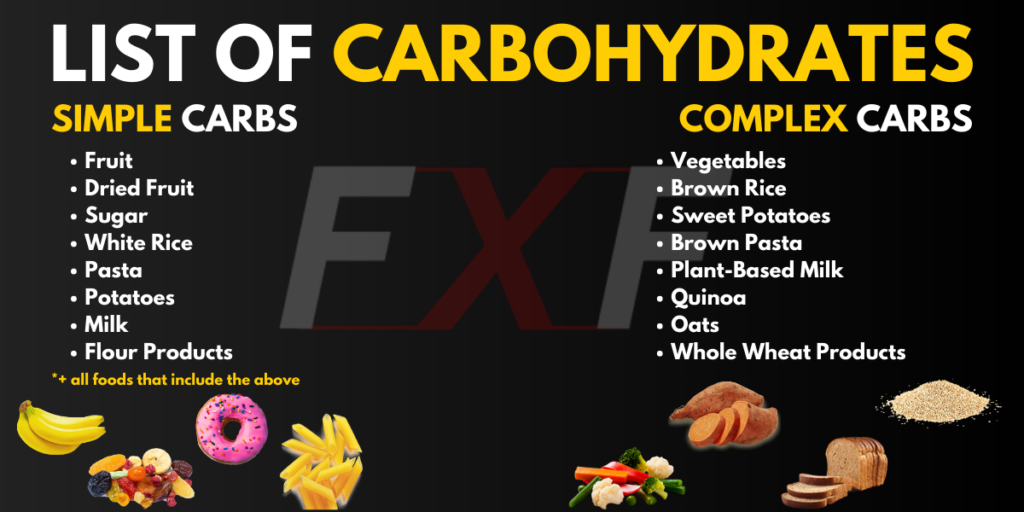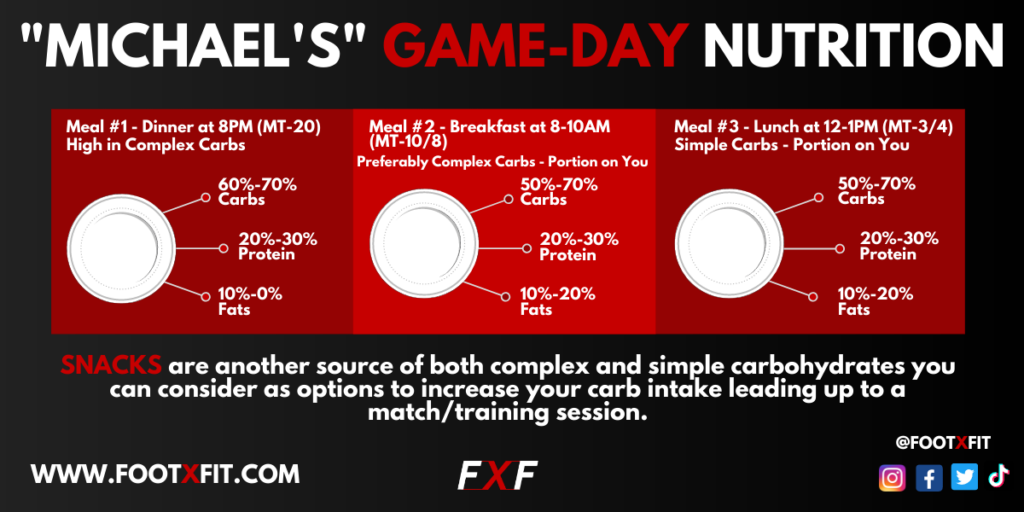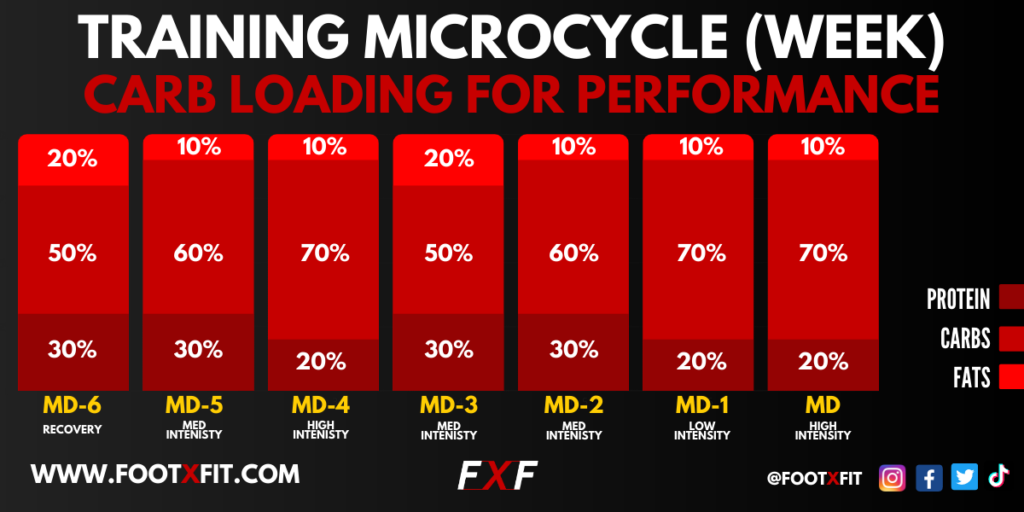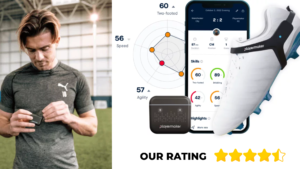
Unfortunately, most footballers do not have access to nutritionists who will lead them to the right path and use every possible way to maximize their performance through nutrition. If you are amongst those athletes and are constantly looking for new ways to educate yourself and transform this knowledge into football success, then I am sure you have heard of a nutritional method called carb-loading.
This basically is a gradual increase of your daily/weekly carbohydrate intake leading up to an intense event. Before we talk about this method, let’s look at some elements that are important for the sake of this article.
NOT IN THE MOOD TO READ? HERE’S THE VIDEO
CARBOHYDRATES & FOOTBALL PERFORMANCE
Carbohydrates are one of the three macronutrients (+ proteins and fats) and one of our main sources of energy. They can be found in foods that contain sugars, starches, and fiber. Carbohydrates are broken down into glycogen. Glycogen is the body’s main source of energy for athletes participating in sports such as football (high-intensity exercise for 90 minutes) and is stored in the muscles and liver for immediate use when needed.
But you might have also heard about the separation of carbohydrates into simple and complex ones. Let’s look at some facts on this subject as well.
SIMPLE CARBOHYDRATES
Simple carbohydrates are monosaccharides (sugars, glucose, fructose) and disaccharides (sugars, lactose, sucrose). How does this translate into food? Below you can see a complete list of different sources of simple carbohydrates. Simple carbohydrates are broken down very easily and quickly by the body, assisting it with quick energy supplies.
ARE THESE “BAD”?
This type of carbohydrate is often treated as “bad” or “unhealthy” in the sports and nutrition industry, mainly because foods that are high in simple carbohydrates usually have a high glycemic index (i.e. sugary beverages) or are high in gluten (i.e. pastries). However, in this article, you will learn how you can even use these seemingly “useless” types of carbohydrates for the benefit of your performance.
COMPLEX CARBOHYDRATES
Complex carbohydrates are polysaccharides (glycogen, fiber). Below you can find another list of foods that are categorized as complex carbohydrates. From the name of these carbohydrates, we understand that their breakdown and absorption by the body is more “complex” and requires more time and effort from our body.
At the moment, complex carbohydrates have a very special place in sports and especially in the nutrition industry, as they are a more stable source of energy over the span of a day.
SO I SHOULD EAT A WHOLE LOT OF THEM, RIGHT?
However, many athletes who eat a diet rich in complex carbohydrates often find themselves experiencing symptoms such as bloating, excess gas, and general stomach disorders, which can often lead to detriments in their performance. So this abuse of otherwise “healthier” and “more efficient” energy sources is not always good.

CARB-LOADING FOR FOOTBALL
Now it,s time to talk about the main topic of this article. Carb-loading!
As mentioned above, carb-loading is a progressive increase of carbohydrate consumption the closer we get to the game/training hour/day. The purpose of this is to “fill” our energy stores with glycogen. Glycogen is a footballer’s main source of energy.
YOU CAN LEARN MORE ABOUT CARB-LOADING IN THIS VIDEO ABOUT GAME-NUTRITION!
We can split down this method into two different scenarios. The first one has to do with the training/competition day and the other with the training/competition week. Then, we will analyze each of them and at the same time showcase some examples/graphs to make their use more clear and illustrative.
HIGH INTENSITY TRAINING/COMPETITION DAY
THE THEORY
The performance of a footballer on the training/match day depends to a large extent on his diet during the last twenty hours pre-training/kick-off. These 20 hours usually include three meals (sometimes snacks as well). So, to personalize this method, I want you to do the following calculation.
- Event starting time – 20 hours = start of diet for the competition/training day
Now that we broke down your diet into three meals, let’s see the type/portion of carbs that is more ideal.

*As an affiliate, I'm earning from qualifying purchases without any extra charges being placed on you.
Meal #1 (20 hours) – Rich in complex carbohydrates, slightly more carbohydrates than normal (from 40%-50% we go to 60%-70%)
Why? – Because they are broken down and absorbed much slower, providing our muscles and liver with a more stable and long lasting energy supply.
Meal # 2 (8-14 hours) – Rich in carbohydrates of your choice (if complex carbohydrates do not cause stomach discomfort, prefer them).
Meal #3 (3-5 hours) – Rich in simple carbohydrates.
Why? – Because their breakdown and absorption is faster and easier on the body, offering a quick and efficient glycogen store refill.
Notes for the last two meals
According to the carb-loading method, the amount of carbohydrates should be bigger in the last meal as we are very close to the main event, however, programming should always be done according to the preferences of the player. The last thing we want is a player that doesn’t feel comfortable with his/her pre-game/training meals!
If you are a footballer who eats a bigger 2nd meal and a smaller pre-game/training meal then increase the amount of carbohydrates only in the 2nd meal (a mix of simple and complex carbohydrates can be useful and convenient here). If you’re “loading” more with your last meal, then limit yourself to a large amount of simple carbohydrates (again around 60% to 70%).
SNACKING?
An additional way to “load” on carbohydrates without particularly increasing the content of them in your main meals is to consume 1 to 3 snacks high in carbohydrates as you get closer to the event. Whether your snacks should be rich in simple or complex carbohydrates is totally dependent upon the time you consume them in relation to your training/kick-off time.
THE EXAMPLE OF MICHAEL

TRAINING/COMPETITION WEEK
By zooming out from the training/competition day, we begin to understand that our performance is affected by the eating habits we follow throughout the whole week and not just 20 hours before an intense event.
When we talk about football we are talking about a microcycle of training and competitive obligations (training/competitive week). This microcycle is usually full. Daily training with at least one game every week and one to two days of recovery).
Questions worth asking yourself
Therefore, it is pretty important to individualize a player’s eating habits to fit their strenuous weekly training schedule. In order to do that, all the details of the training week need to be laid out. When is the individual training/recovering/playing a game? Which days are more intense and which lighter? How is the player feeling?

*As an affiliate, I'm earning from qualifying purchases without any extra charges being placed on you.
By doing that, he/she will be able to clarify during which days he/she needs more carbohydrates (demanding days – high-intensity training/game-day) and which fewer (less intense days – low-intensity training, recovery days).
The rationale behind this method is simple: if on the least demanding days your body does not consume large amounts of energy then you do not need to consume as many carbohydrates. The opposite of course applies to more strenuous days.
But into what does this translate numerically? The amount in grams that each person has in their meals and diet, in general, is sure to differ from athlete to athlete, so we will talk in percentages. An increase of 10% (or even 20%) can cause the changes we want. Below I have a graph/sample to make the method better understood.

Please note that these are only samples to help you better understand how carb-loading works. Always adjust to your own needs and don’t forget to listen to your body. Try out different approaches, see how your body reacts and choose the one that fits the best. Professional advice and programming from a nutritionist would be more ideal if you can afford it.
RELATED ARTICLES
- 10 Lunch Ideas For Football | Meals High In Carbohydrates
- Sports Drinks – Hypotonic, Isotonic, Hypertonic | What’s The Difference & How To Make One At-Home
- Match-Day Nutrition For Football Players | Everything You Need To Know
- Smoothies For Footballers | This Is How To Fill Your Nutritional Gaps
- 15 Great Snacks To Boost Football Performance
- A Footballer’s Diet Plan | This Is How To Create Yours




